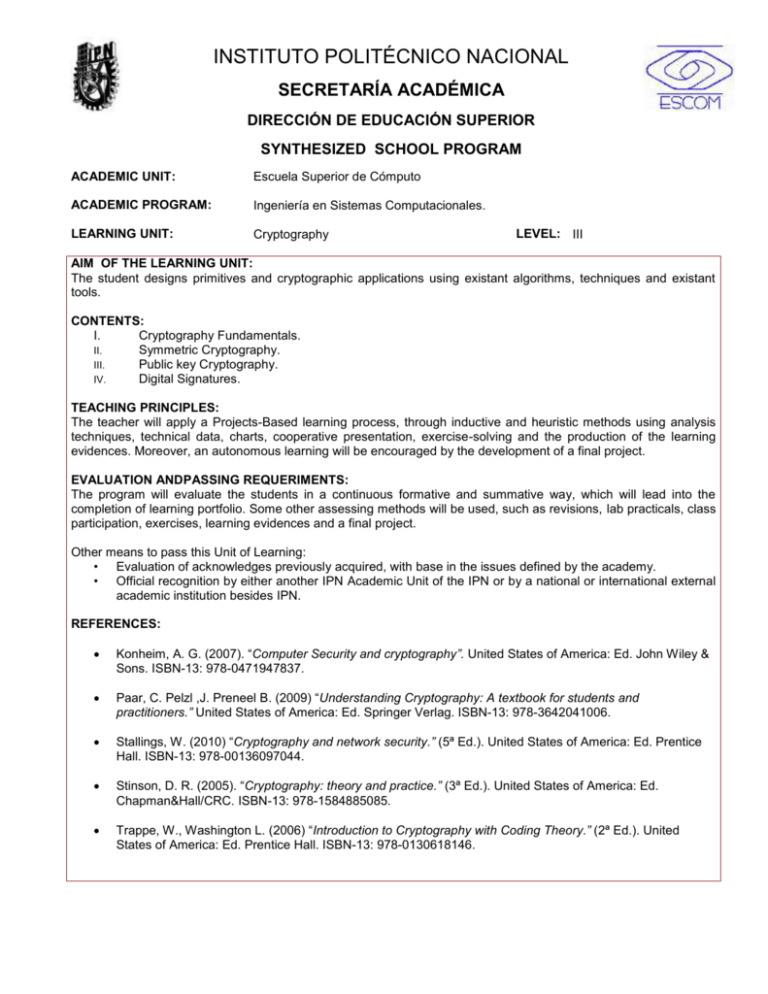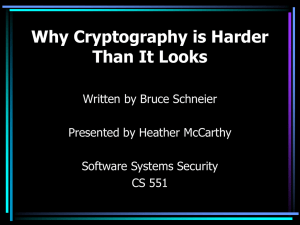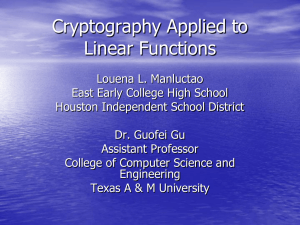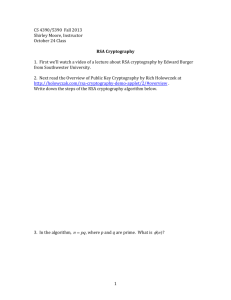Cryptography
advertisement

INSTITUTO POLITÉCNICO NACIONAL SECRETARÍA ACADÉMICA DIRECCIÓN DE EDUCACIÓN SUPERIOR SYNTHESIZED SCHOOL PROGRAM ACADEMIC UNIT: Escuela Superior de Cómputo ACADEMIC PROGRAM: Ingeniería en Sistemas Computacionales. LEARNING UNIT: Cryptography LEVEL: III AIM OF THE LEARNING UNIT: The student designs primitives and cryptographic applications using existant algorithms, techniques and existant tools. CONTENTS: I. Cryptography Fundamentals. II. Symmetric Cryptography. III. Public key Cryptography. IV. Digital Signatures. TEACHING PRINCIPLES: The teacher will apply a Projects-Based learning process, through inductive and heuristic methods using analysis techniques, technical data, charts, cooperative presentation, exercise-solving and the production of the learning evidences. Moreover, an autonomous learning will be encouraged by the development of a final project. EVALUATION ANDPASSING REQUERIMENTS: The program will evaluate the students in a continuous formative and summative way, which will lead into the completion of learning portfolio. Some other assessing methods will be used, such as revisions, lab practicals, class participation, exercises, learning evidences and a final project. Other means to pass this Unit of Learning: • Evaluation of acknowledges previously acquired, with base in the issues defined by the academy. • Official recognition by either another IPN Academic Unit of the IPN or by a national or international external academic institution besides IPN. REFERENCES: Konheim, A. G. (2007). “Computer Security and cryptography”. United States of America: Ed. John Wiley & Sons. ISBN-13: 978-0471947837. Paar, C. Pelzl ,J. Preneel B. (2009) “Understanding Cryptography: A textbook for students and practitioners.” United States of America: Ed. Springer Verlag. ISBN-13: 978-3642041006. Stallings, W. (2010) “Cryptography and network security.” (5ª Ed.). United States of America: Ed. Prentice Hall. ISBN-13: 978-00136097044. Stinson, D. R. (2005). “Cryptography: theory and practice.” (3ª Ed.). United States of America: Ed. Chapman&Hall/CRC. ISBN-13: 978-1584885085. Trappe, W., Washington L. (2006) “Introduction to Cryptography with Coding Theory.” (2ª Ed.). United States of America: Ed. Prentice Hall. ISBN-13: 978-0130618146. INSTITUTO POLITÉCNICO NACIONAL SECRETARÍA ACADÉMICA DIRECCIÓN DE EDUCACIÓN SUPERIOR ACADEMIC UNIT: Escuela Superior de Cómputo. ACADEMIC PROGRAM: Ingeniería en Sistemas Computacionales LATERAL OUTPUT: Analista Programador de Sistemas de Información. FORMATION AREA: Professional. MODALITY: Presence. LEARNING UNIT: Cryptography TYPE OF LEARNING UNIT: Theorical - Practical, Optative. USE: August, 2011 LEVEL: III. CREDITS: 7.5 Tepic, 4.39 SATCA EDUCATIVE AIM This learning unit enhances the profile of graduates in Computer Systems Engineering providing cryptographic techniques and tools that allows to protect information in a computer system. It also helps develop strategic and creative thinking, collaborative work and assertive communication. Learning units required are Algorithm and Structured Programming, Data Structure, Object-Oriented Programming, Discrete Mathematics and Probability. The subsequent units are Work Safety and Terminal Work I and II. AIM OF THE LEARNING UNIT: The student designs primitives and cryptographic applications using existant algorithms, techniques and existant tools. CREDITS HOURS LEARNING UNIT DESIGNED BY: Academia de Sistemas Distribuidos. THEORETICAL CREDITS / WEEK: 3.0 PRACTICAL CREDITS / WEEK: 1.5 HOURS THEORETICAL /TERM: 54 AUTHORIZED BY: Comisión de Programas Académicos del Consejo General Consultivo del IPN REVISED BY: Dr. Flavio Arturo Sánchez Garfias. Subdirección Académica HOURS PRACTICAL / SEMESTER: 27 HOURS AUTONOMOUS LEARNING: 54 CREDITS HOURS / SEMESTER: 81 APPROVED BY: Ing. Apolinar Francisco Cruz Lázaro. Presidente del CTCE Ing. Rodrigo de Jesús Serrano Domínguez Secretario Técnico de la Comisión de Programas Académicos INSTITUTO POLITÉCNICO NACIONAL SECRETARÍA ACADÉMICA DIRECCIÓN DE EDUCACIÓN SUPERIOR LEARNING UNIT: PAGE: Cryptography 3 OUT OF 10 N° THEMATIC UNIT: I TITLE: Cryptography Fundamentals UNIT OF COMPETENCE The student relates the characteristics of a cryptographic system based on its primitives and services. No. Teacher ledinstruction HOURS CONTENTS Autonomous Learning HOURS Definition and importance of cryptography T 1.0 P 1.1 1.2 Cryptographic services. 1.0 0.5 1.3 Cryptographic system characteristics 0.5 1.0 Attacks Ciphertext only Known plaintext Chosen plaintext Chosen ciphertext 2.0 1.0 1.4 1.4.1 1.4.2 1.4.3 1.4.4 T 0.5 P 0.5 1.0 REFERENCES KEY 2B, 3B, 4B, 5B, 1C Subtotals: 4.5 0.5 3.0 1.0 TEACHING PRINCIPLES This Thematic Unit will be Projects-Based learning strategy, trough heuristic method, with the techniques of elaboration of charts, documentary research, brainstorming, technical data and exercise-solving, lab practical and production of learning evidence and the accomplishment of a project proposal. LEARNING EVALUATION Assessment Portfolio of Evidences: Charts Technical data Exercise-solving Proposal of project Rubric of Self-Evaluation Rubric of Co-Evaluation Learning Evidence 5% 5% 25% 20% 2% 3% 40% INSTITUTO POLITÉCNICO NACIONAL SECRETARÍA ACADÉMICA DIRECCIÓN DE EDUCACIÓN SUPERIOR LEARNING UNIT: PAGE: Cryptography 4 OUT OF 10 N° THEMATIC UNIT: II NAME: Symmetric Cryptography UNIT OF COMPETENCE The student develops symmetric cryptographic protocols based on private key ciphers. No. Teacher ledinstruction HOURS CONTENTS T P Autonomous Learning HOURS T P 2.1 Symmetric cryptography characteristics 0.5 0.5 2.2 Perfect secrecy 1.0 2.0 2.3 Classical cryptosystems 1.0 1.0 2.0 2.0 Modern cryptography algorithms Stream ciphers Block ciphers Security 3.0 1.0 6.0 2.0 Modes of operation 0.5 0.5 1.0 1.0 2.4 2.4.1 2.4.2 2.4.3 2.5 REFERENCES KEY 2B,3B,4B,5B,1C Subtotals: 6.0 2.5 11.5 5.0 TEACHING PRINCIPLES Will be projects-Based learning strategy, trough heuristic method, with the techniques of charts, exercise-solving, cooperative presentation, advance of the project, lab practical and the production of the learning evidences. LEARNING EVALUATION Portfolio of Evidences: Charts Comparison table Exercise-solving Lab practical reports Advance of the project Rubric of self-evaluation Rubric of co-evaluation Evidence of learning 5% 5% 5% 20% 20% 2% 3% 40% INSTITUTO POLITÉCNICO NACIONAL SECRETARÍA ACADÉMICA DIRECCIÓN DE EDUCACIÓN SUPERIOR LEARNING UNIT: PAGE: Cryptography THEMATIC UNIT: III 5 OUT OF 10 TITLE: Public key Cryptography UNIT OF COMPETENCE The student implements public key cryptography protocols, using modular arithmetic. No. 3.1 3.2 3.3 3.3.1 3.3.2 3.3.3 3.3.4 3.4 3.4.2 3.4.3 Teacher ledinstruction HOURS CONTENTS Public key cryptography characteristics. Integers modulo n. Number theory Extended Euclidean algorithm Fermat’s theorem Chinese remainder theorem Intractable problems in number theory Public key algorithms Key exchange Encryption algorithms T 0.5 1.0 2.5 1.0 P 2.0 1.0 Autonomous Learning HOURS T 0.5 2.5 6.0 4.0 3.5 3.5 REFERENCES KEY P 3B,4B,5B,1C Subtotals: 5.0 3.0 12.5 7.5 TEACHING PRINCIPLES Will be projects-Based learning strategy, through inductive and heuristic methods, with the techniques of elaboration of exercise-solving, cooperative presentation, practical and learning evidence, the production of the learning evidences and advance of the project. LEARNING EVALUATION Project portfolio: Charts 5% Exercise-solving 5% Technical data 5% Lab practical reports 20% Advance of the Project 20% Self-Evaluation rubrics 2% Cooperative Evaluation rubrics 3% Written learning Evidence 40% INSTITUTO POLITÉCNICO NACIONAL SECRETARÍA ACADÉMICA DIRECCIÓN DE EDUCACIÓN SUPERIOR LEARNING UNIT: PAGE: Cryptography THEMATIC UNIT: IV 6 OUT OF TITLE: Digital signatures UNIT OF COMPETENCE The student solves authentication problems in a computer system using digital signatures. No. 4.1 4.1.1 4.1.2 4.2 4.3 4.3.1 4.3.2 4.3.3 Teacher ledinstruction HOURS CONTENTS Hash functions Birthday attack Collisions Message authentication codes: MAC Digital signatures. RSA signature scheme ElGamal signature scheme Digital Signature Algorithm (DSA) Autonomous Learning HOURS T P T P 1.0 1.0 3.0 2.0 1.0 1.5 0.5 0.5 2.0 3.0 1.0 2.5 REFERENCES KEY 3B,4B,5B, 1C Subtotals: 3.5 2.0 8.0 5.5 TEACHING PRINCIPLES Will be projects-Based learning strategy, trough inductive and heuristic methods, with the techniques of cooperative presentation, practical, the production of the learning evidences and the presentation of the final project. LEARNING EVALUATION Project Portfolio: Charts 5% Report of project 40% Lab practical reports 20% Self-Evaluation rubrics 2% Cooperative Evaluation rubrics 3% Written learning Evidence 30% 10 INSTITUTO POLITÉCNICO NACIONAL SECRETARÍA ACADÉMICA DIRECCIÓN DE EDUCACIÓN SUPERIOR LEARNING UNIT: PAGE: Cryptography 7 OUT OF RECORD OF PRACTICALS No. NAME OF THE PRACTICAL THEMATIC UNITS DURATION 1 Vigenère cipher. I 1.5 2 Cryptanalysis of Vigenère cipher. II 1.5 3 Hill cipher and its cryptanalysis II 1.5 4 Block cipher algorithm II 3.0 5 Block ciphers and modes of operation CBC and CTR. II 1.5 6 Extended Euclidena algorithm. III 1.5 7 Prime factorization. III 1.5 8 Discrete logarithm in Zp. III 1.5 9 Diffie-Hellman scheme. III 1.5 10 Primality test. III 1.5 11 Public key encrytion. III 3.0 12 Standard hash functions. IV 3.0 13 MAC. IV 1.5 14 Digital Signature Algorithm DSA. IV 3.0 TOTAL OF HOURS 27.0 EVALUATION AND PASSING REQUIREMENTS: The lab practicals are considered mandatory to pass this learnig unit. The lab practicals worth 20% in the thematic units II, III and IV. ACCOMPLISHMENT LOCATION Computer Labs. 10 INSTITUTO POLITÉCNICO NACIONAL SECRETARÍA ACADÉMICA DIRECCIÓN DE EDUCACIÓN SUPERIOR LEARNING UNIT: PAGE: Cryptography PERIOD UNIT 1 2 3 I y II III IV 8 OUT OF 10 EVALUATION TERMS Continuous evaluation 60% and written learning evidence Continuous evaluation 60% and written learning evidence Continuous evaluation 70% and written learning evidence 40% 40% 30% The learning unit I worth 15% of final score The learning unit I worth 18% of final score The learning unit I worth 33% of final score The learning unit I worth 34% of final score Other means to pass this Learning Unit: • Evaluation of acknowledges previously acquired, with base in the issues defined by the academy. • Official recognition by either another IPN Academic Unit of the IPN or by a national or international external academic institution besides IPN. If accredited by Special Assessment or a certificate of proficiency, it will be based on guidelines established by the academy on a previous meeting for this purpose. INSTITUTO POLITÉCNICO NACIONAL SECRETARÍA ACADÉMICA DIRECCIÓN DE EDUCACIÓN SUPERIOR LEARNING UNIT: KEY Cryptography. B 1 C X PAGE: 9 OUT OF 10 REFERENCES Konheim, A. G. (2007). Computer Security and cryptography. United States of America: Ed. John Wiley & Sons. ISBN-13: 978-0471947837. 2 X Paar, C. Pelzl, J. Preneel B. (2009). Understanding Cryptography: A textbook for students and practitioners. United States of America: Ed. Springer Verlag. ISBN-13: 978-3642041006. 3 X Stallings, W. (2010). Cryptography and network security (5ª Ed.). United States of America: Ed. Prentice Hall. ISBN-13: 97800136097044. 4 X Stinson, D. R. (2005). Cryptography: theory and practice (3ª Ed.). United States of America: Ed. Chapman&Hall/CRC. ISBN-13: 978-1584885085. 5 X Trappe, W. Washington, L. (2006). Introduction to Cryptography with Coding Theory (2ª Ed.). United States of America: Ed. Prentice Hall. ISBN-13: 9780130618146. INSTITUTO POLITÉCNICO NACIONAL SECRETARÍA ACADÉMICA DIRECCIÓN DE EDUCACIÓN SUPERIOR TEACHER EDUCATIONAL PROFILE PER LEARNING UNIT 1. GENERAL INFORMATION ACADEMIC UNIT: ACADEMIC PROGRAM: FORMATION AREA: ACADEMY: Escuela Superior de Cómputo. LEVEL Ingeniería en Sistemas Computacionales. Institutional Sistemas Distribuidos. Basic Scientific LEARNING UNIT: SPECIALTY AND ACADEMIC REQUIRED LEVEL: Professional III Terminal and Integration Cryptography. Masters Degree or Doctor in Computer Science. 2. AIM OF THE LEARNING UNIT: The student designs primitives and cryptographic applications using existant algorithms, techniques and existant tools. 3. PROFESSOR EDUCATIONAL PROFILE: KNOWLEDGE Cryptographic algorithms Algebra. Computer Security protocols. Algorithmic complexity. Programming languages Knowledge of the Institutional Educational Model. English. PROFESSIONAL EXPERIENCE ABILITIES A year cryptograpy Actual in educational as facilitator of the knowledge of two years. A year experience in the Institutional Educational Model. Facility with Problems resolution. Cooperative. Leadership. Applications of Institutional Educational Model. Decision making. APTITUDES Responsible. Patient Tolerant. Respectful. Collaborative. Participative. Interested to learning. Assertive. DESIGNED BY REVISED BY AUTHORIZED BY M. en C. Nidia Asunción Cortez Duarte M. en C. Sandra Díaz Santiago COLLABORATING PROFESSORS Dr. Flavio Arturo Sánchez Garfias Subdirector Académico Ing. Apolinar Francisco Cruz Lázaro Director Date: 2011






